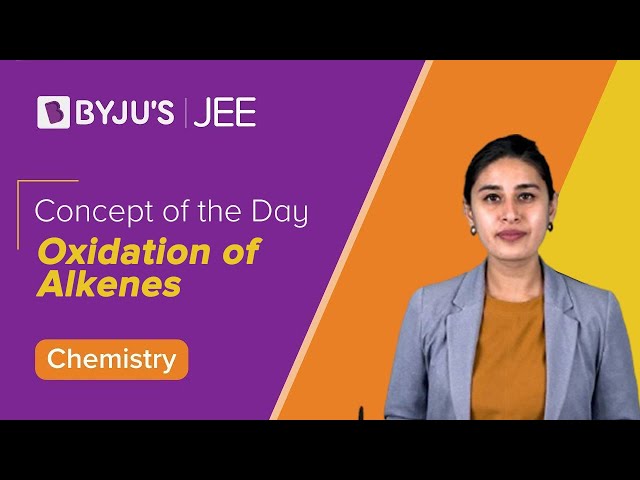Ozonolysis refers to the organic chemical reaction where ozone is employed to cleave the unsaturated bonds of alkenes, alkynes, and azo compounds (compounds with the functional diazenyl functional group). It is an organic redox reaction.
Table of Content
What is Ozonolysis?
Oxidation of alkenes with the help of ozone can give alcohols, aldehydes, ketones, or carboxylic acids. Alkynes undergo ozonolysis to give acid anhydrides or diketones. If water is present in the reaction, the acid anhydride undergoes hydrolysis to yield two carboxylic acids. Ozonolysis of elastomers is also known as ozone cracking. Trace amounts of ozone gas in the atmosphere cuts the double bonds in elastomers. For azo compounds, the ozonolysis yields nitrosamines.
Ozonolysis Reaction
Ozone is a very reactive allotrope of oxygen. The reaction of ozone with alkenes and alkynes causes the oxidative cleaving of the alkene or alkyne. The carbon-carbon triple bonds are replaced with carbon-oxygen double bonds, giving the required carbonyl product as shown below.

Ozonolysis Mechanism
The Ozonolysis mechanism proceeds via an oxidative cleavage reaction. The ozone not only breaks the carbon pi bond but also the carbon-carbon sigma bond. It involves the attack of ozone on the given reactant to form an ozonide. To eliminate the oxygen in this intermediate stage, zinc dust is employed (since it forms zinc oxide with oxygen). The final product varies based on the type of reactant and the workup. Given below is an illustration depicting the general mechanism of the ozonolysis reaction for alkenes and alkynes.
Recommended Videos

Ozonolysis of Alkenes
Alkenes can undergo ozonolysis to form alcohols, aldehydes, ketones, or carboxylic acids. The general procedure uses a solution of alkene in methanol. Ozone is bubbled through this solution at approximately 780 Celsius. When the solution turns blue, the alkene is consumed (the blue colour comes from the unreacted ozone). Other indicators of the endpoint of the reaction include potassium iodide solution. For this indicator, a stream of ozone enriched oxygen is bubbled through a mixture of the reactants. The gas that bubbles out is channelled through a solution of potassium iodide. Once the reaction is complete and there is no more alkene left to react with the ozone, the gas goes on to oxidize potassium iodide to iodine. The reaction of potassium iodide with ozone to give iodine is indicated by the distinct violet colour of iodine.
Once the ozone is added to the reaction mixture, a reagent must be added to convert the ozonide to the required carbonyl derivative. For this conversion, 2 techniques can be employed:
- Reductive Workup
- Oxidative Workup
However, reductive workup conditions seen a lot more in use when compared to oxidative workup conditions. In these workup conditions, triphenylphosphine, thiourea, zinc dust, and dimethyl sulfide can be used to produce aldehydes or ketones. On the other hand, hydrogen peroxide can be used to produce carboxylic acids. Ozone can also be employed to oxidize other functional groups such as benzyl ethers. Pyridine is also used to buffer the reaction since small amounts of acid may be generated at the time of reaction. A 1:1 ratio of solvent with dichloromethane co-solvent facilitates the timely cleavage of the ozonide. Ozonolysis of oleic acid is used to produce azelaic acid and pelargonic acid on an industrial scale.
Ozonolysis of Alkenes Mechanism
Step 1
The electrophilic addition of ozone to the carbon-carbon bond forms the molozonide intermediate which is quite unstable. Due to this unstable nature, the molozonide continues reacting – breaking apart to form a carbonyl molecule and a carbonyl oxide molecule as shown below:

Step 2
The carbonyl molecule and the carbonyl oxide molecule formed in step 1 rearrange themselves, reforming to create a more stable ozonide intermediate. This ozonide intermediate can be subjected to either an oxidative workup or a reductive workup. The oxidative workup will give carboxylic acid as the product whereas the reductive workup will yield aldehydes or ketones.
The formation of the ozonide intermediate is illustrated below.

Oxidative Workup
When oxidant hydrogen peroxide is used instead of zinc or dimethyl sulfide to treat the ozonide, the aldehydes formed are oxidized to carboxylic acids. Potassium Permanganate in the presence of hot acid can also be used in the oxidative workup.

Reductive Workup
Here, the ozonide is treated with mild reducing agents such as dimethyl sulfide and zinc metal with water. The ozonide is reduced as shown below.
Ozonolysis of Alkynes
Alkynes undergo ozonolysis to give an acid anhydride or a diketone as the final product. The fragmentation is not complete in this reaction (alkenes undergo complete fragmentation). No reducing agents are required as a simple aqueous workup is followed. If the reaction happens in the presence of water, the acid anhydride undergoes hydrolyzation to give two carboxylic acids. Ozonolysis can also be used to determine the position of the triple bond in an unknown alkyne. A few examples of alkyne ozonolysis are provided below:

Ozonolysis of Alkynes Mechanism
The alkyne reacts with the ozone, causing the breakage of the alkyne. This gives rise to the ozonide intermediate. A simple aqueous workup follows with the help of zinc metal, finally yielding a dicarbonyl compound. The reaction can be written as:

Ozonolysis of Elastomers – Ozone Cracking
The attack of ozone (present in trace amounts in the atmosphere) on the elastomer creates cracks. The double bond in the rubber chain is attacked by the ozone here. If the rubber product is under tension, ozone cracks begin to form. The cracks can appear around the circumference of a bent rubber tube since they are oriented at right angles to the axis of strain. These cracks are extremely dangerous when they occur in fuel pipes, growing inward from the exposed exterior surface. This can even lead to fuel leakage and fires.
Thus, ozone can be employed to cleave unsaturated bonds in alkenes, alkynes, and azo compounds. This cleaving is used in the organic chemical reaction called ozonolysis.
Understanding Ozonolysis

Oxidation of Alkenes

Frequently Asked Questions – FAQs
What is ozonolysis?
Ozonolysis refers to the organic chemical reaction where ozone is employed to cleave the unsaturated bonds of alkenes, alkynes, and azo compounds. It is an organic redox reaction.
What does oxidation of alkenes by ozone give?
The oxidation of alkenes by ozone gives alcohols, aldehydes, ketones, or carboxylic acids as a product.
What does oxidation of alkynes by ozone give?
The oxidation of alkynes by ozone gives acid anhydrides or diketones. If water is present in the reaction, the acid anhydride undergoes hydrolysis to yield two carboxylic acids.
What is the parent hydrocarbon if a compound on ozonolysis gives ethanal and methanal as the major product?
Prop-1-ene gives ethanal and methanal as the major product on ozonolysis.
What is the mechanism of ozonolysis reaction?
Ozonolysis reactions take place in two steps: Initially ozone attacks alkene molecules to form ozonide and then hydrolysis takes place leading to bond cleavage.



superb
Hi, your app is more helping us